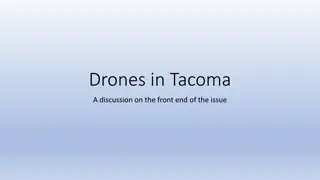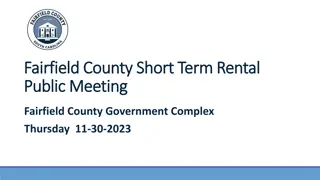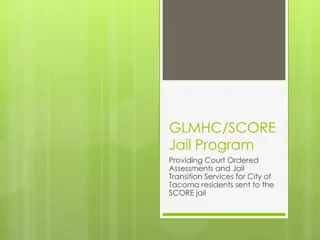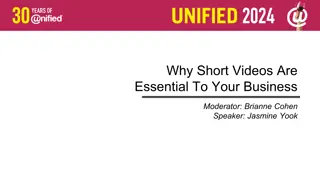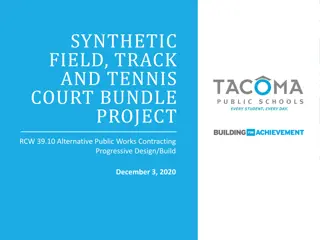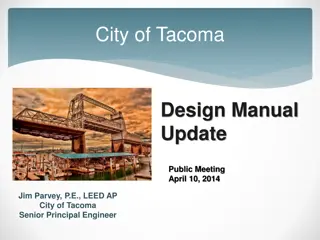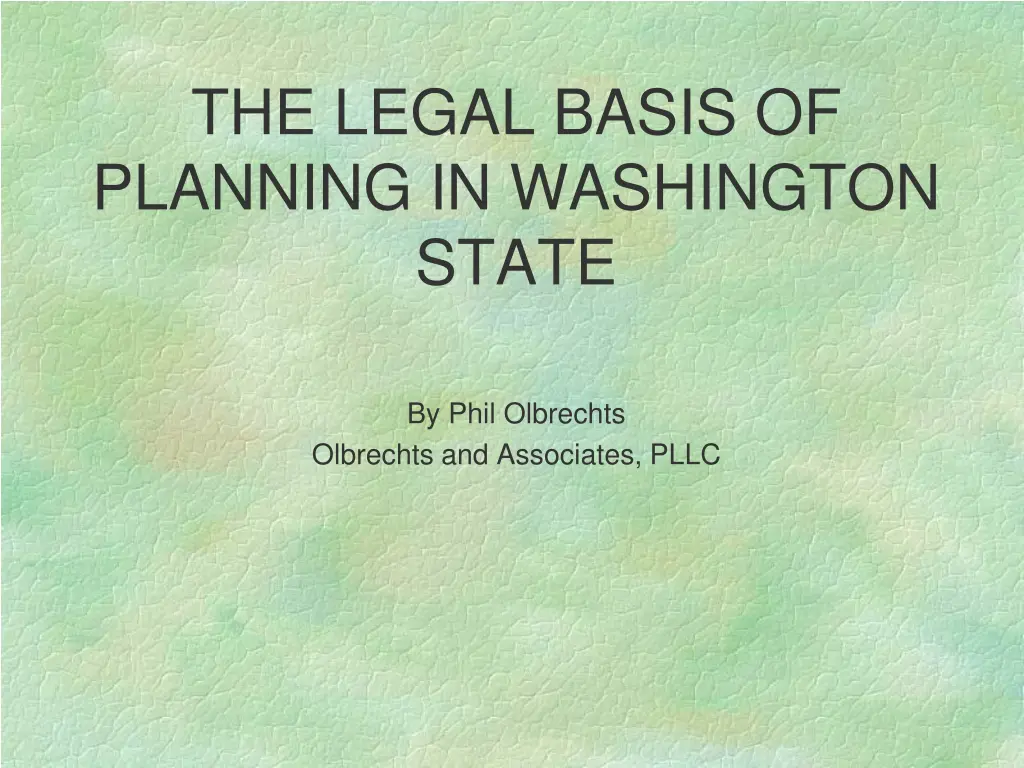
Legal Basis of Planning in Washington State
Explore the legal framework governing planning in Washington State, including statutes dating back to 1857. Learn about the roles of different entities in zoning, the Appearance of Fairness Doctrine, and significant acts like the Open Public Meetings Act. Discover key provisions such as the right to seek damages for arbitrary agency actions in property permit applications.
Download Presentation

Please find below an Image/Link to download the presentation.
The content on the website is provided AS IS for your information and personal use only. It may not be sold, licensed, or shared on other websites without obtaining consent from the author. If you encounter any issues during the download, it is possible that the publisher has removed the file from their server.
You are allowed to download the files provided on this website for personal or commercial use, subject to the condition that they are used lawfully. All files are the property of their respective owners.
The content on the website is provided AS IS for your information and personal use only. It may not be sold, licensed, or shared on other websites without obtaining consent from the author.
E N D
Presentation Transcript
THE LEGAL BASIS OF PLANNING IN WASHINGTON STATE By Phil Olbrechts Olbrechts and Associates, PLLC
I. WASHINGTON PLANNING STATUTES - CHRONOLOGICAL Subdivision Codes (1857, 1937, 1969) The City legislative body . Shall determine if appropriate provisions are made for, but not limited to, the public health, safety, and general welfare, for open spaces, drainage ways, streets, alleys, other public ways, water supplies, sanitary wastes, parks, playgrounds, sites for schools and school grounds, and shall consider all other relevant facts, including sidewalks and other planning features that assure safe walking conditions for students who walk to and from school, and determine whether the public interest will be served by the subdivision and dedication.
I. WASHINGTON PLANNING STATUTES - CHRONOLOGICAL The Planning Enabling Act (1935) Village of Euclid v. Ambler Realty Co., 272 U.S. 365 (1926) You too can zone if: (1) (2) The Zoning Players: (1) (2) (3) (4) (5) Planning Commission/Agency Comprehensive Plan Staff Planning Commission/Agency Board of Adjustment Hearing Examiner City Council
I. WASHINGTON PLANNING STATUTES - CHRONOLOGICAL The Appearance of Fairness Doctrine (1969, 1982)
I. WASHINGTON PLANNING STATUTES - CHRONOLOGICAL The Roaring 70 s The Open Public Meetings Act (1971) The State Environmental Policy Act (1971) The Shoreline Management Act (1971)
I. WASHINGTON PLANNING STATUTES - CHRONOLOGICAL 64.40 (1982) Owners of a property interest who have filed an application for a permit have an action for damages to obtain relief from acts of an agency which are arbitrary, capricious, unlawful, or exceed lawful authority, or relief from a failure to act within time limits established by law: PROVIDED, That the action is unlawful or in excess of lawful authority only if the final decision of the agency was made with knowledge of its unlawfulness or that it was in excess of lawful authority, or it should reasonably have been known to have been unlawful or in excess of lawful authority.
I. WASHINGTON PLANNING STATUTES - CHRONOLOGICAL The Growth Management Act (1990) - Concurrency/Capital Facilities - Urban Growth Areas - Critical Area Ordinances
I. WASHINGTON PLANNING STATUTES - CHRONOLOGICAL The Regulatory Reform Act (1995)
I. WASHINGTON PLANNING STATUTES - CHRONOLOGICAL The Land Use Petition Act (1995)
II. PLANNING AND THE CONSTITUTION The basic rule in land use law is still that, absent more, an individual should be able to utilize his land as he sees fit. Norco Construction v. King County, 97 Wn.2d 680, 685 (1982)
II. PLANNING AND CONSTITUTION A. Takings - Thou shalt not take property without just compensation. Regulatory takings - $$$ if regulations deprive all use. Exactions - nexus and proportionality. Reasonable use exceptions. - - -
II. PLANNING AND CONSTITUTION A. Takings - Thou shalt not take property without just compensation. Regulatory takings - ### if regulations deprive all use. Exactions - nexus and proportionality. Reasonable use exceptions. - - -
II. PLANNING AND THE CONSTITUTION B. Substantive and Procedural Due Process - - Reasonable, reasonable, reasonable. Void for vagueness.
II. PLANNING AND CONSTITUTION C. Equal Protection - Protected Classes.
II. PLANNING AND CONSTITUTION D. Freedom of Expression/Religion - Churches and strip clubs.
III. THE OPEN PUBLIC MEETINGS ACT Chapter 42.30 RCW 1. Purpose of the Act 2. Open Meetings Required 3. Executive Sessions 4. Expulsion of Meeting Participants 5. Basic Requirements for Meetings 6. Penalties 7. Exemptions
PURPOSE - RCW 42.30.010 The legislature finds and declares that all public commissions, boards, councils, committees, subcommittees, departments, divisions, offices, and all other public agencies of this state and subdivisions thereof exist to aid in the conduct of the people s business. It is the intent of this chapter that their actions be taken openly and that their deliberations be conducted openly. The people of this state do not yield their sovereignty to the agencies which serve them. The people, in delegating authority, do not give their public servants the right to decide what is good for the people to know and what is not good for them to know. The people insist on remaining informed so that they may retain control over the instrument they have created.
OPEN MEETINGS REQUIRED RCW 42.30.030 All meetings of the governing body of a public agency shall be open and public and all persons shall be permitted to attend any meeting of the governing body of a public agency, except as otherwise provided in this chapter.
WHAT COMMITTEES MUST HOLD OPEN MEETINGS? Givens: City Council Planning Commission Civil Service Commission Board of Adjustment Depends: Library Boards Park Boards Council Committees
WHAT IS A MEETING? County Commissioners, City Councils, Planning Commissions: Quorum + Action Subcommittees: Holds Hearings, Takes Public Comment, or Acts on Behalf of Governing Body
Emails Email exchanges can be OPMA meetings Emails can be public records subject to public disclosure Emails can be public records that cannot be destroyed
EXECUTIVE SESSIONS Personnel Litigation Real Estate
EXPULSION OF MEETING PARTICIPANTS Options: Recess Adjourn Removal Adjourn to a New Location
BASIC REQUIREMENTS FOR MEETINGS Regular meetings Special meetings Adjourned meetings By committee By clerk
PENALTIES Committee members: $100 fine for knowing violation City: Attorney fees. Actions taken during illegal meetings are null and void
IV. APPEARANCE OF FAIRNESS DOCTRINE 1. 2. 3. 4. 5. 6. Who, What, Where and Why? Exceptions Applications Violation Consequences Compliance Strategies Conduct of Hearings
WHO, WHAT, WHERE AND WHY? A. Origins B. Chapter 42.36 RCW C. The Test ($$) D. Quasi-Judicial Actions E. Ex Parte Contracts ( Death of Democracy )
ORIGINS Magic: Smith v. Skagit County, 75 Wn.2d 715, 739, 453 P.2d 832 (1969) Legislature: Chapter 42.36 RCW
THE TEST ($$) Land Use Attorney Employment Test Would a reasonable person, apprised of the totality of a member s personal interest or involvement be reasonably justified in thinking that the involvement might affect the member s judgment? Swift v.Island County, 87 Wn. 348, 361, 552 P.2d 175 (1976).
QUASI-JUDICIAL ACTIONS Acting like a judge: Specific Parties Hearing or other contested action Determine Rights, Duties or Privileges
QUASI-JUDICIAL EXAMPLES Yea: Development Permit Applications, site-specific rezones Nay: Comp Plan Amendments, Area- Wide Rezones
EX PARTE CONTACTS DEATH OF DEMOCRACY The Rule: No ex parte contacts with opponents or proponents during pendency of quasi-judicial action Exception: Disclose substance and offer rebuttal
EXCEPTIONS A. Regular business exception B. Doctine of necessity C. Waiver D. Campaign statements/contributions
REGULAR BUSINESS EXCEPTION No members of a local decision- making body may be disqualified by the appearance-of-fairness doctrine for conducting the business of his or her office with any constituent on any matter other than a quasi-judicial action then pending before the local legislative body.
DOCTRINE OF NECESSITY AOF doesn t apply if it results in loss of quorum or majority needed to approve pending matter. Must disclose basis for disqualification prior to rendering decision.
WAIVER Use it or lose it
CAMPAIGN STATEMENTS RCW 42.36.040: Prior to declaring as a candidate for public office or while campaigning for public office as defined by RCW 42.17.020(5) and (25) no public discussion or expression of an opinion by a person subsequently elected to a public office, on any pending or proposed quasi-judicial actions, shall be a violation of the appearance-of-fairness doctrine.
APPLICATIONS Prejudgment Business relationships Social/marital relationships Membership and organizations Personal benefit/detriment Ex Parte contacts/evidence outside record
VIOLATION CONSEQUENCES Action void Damages?
COMPLIANCE STRATEGIES Step down Get out Start over
V. CONDUCT OF HEARINGS A. Must be fair in fact B. Must appear fair C. Procedures D. Suggested order of presentation E. Deliberation
PROCEDURES Must have ability to produce a verbatim transcript Assign a number or letter to each exhibit and refer to those numbers or letters thereafter Have each speaker identify him/herself Have the Chairman recognize each speaker, so you know who is speaking Be sure to have each speaker speak into the microphone Do not verbally step on each other; no side bar conversations; don t rattle papers by the microphone Be sure to have the clerk or secretary monitor that the machine is recording You may impose reasonable time limits You may encourage speakers not to be repetitive In imposing time limits be aware of potential unfairness if multiple speakers request time on one side of the issue
SUGGESTED ORDER OF PRESENTATION Inquiry by Chairman of any Commission members have any conflict- of-interest or appearance of fairness problems Challenges from the audience on the basis of appearance of fairness May ask legal counsel to review criteria Open hearing Staff presentation and Commission questions Speakers who have signed up indicating a desire to speak Persons in the audience who have not signed up to speak but desire to speak Applicant s response/rebuttal Staff s response/rebuttal Close hearing
DELIBERATION Discussion - why supporting approval or disapproval. Base reasons on criteria and ordinances or State law. Point out how proposal does or does not meet criteria. Base reasons on written and oral record. Motion to approve or disapprove should instruct the staff to prepare draft findings and conclusions in line with the discussion to be presented at the next regular meeting for final approval and passage by Commission.
VI. DECISION a. Must be in writing. b. Must be based on evidence deduced from the record. c. A court will review the body s decision on the basis of whether or not there is substantial evidence in the record to support the decision. d. Facts must support the conclusions.
WHY FINDINGS Judicial Deference to Findings and Conclusions. Aid Court in Determining if Evidence Supports Decision. Avoid Usurpation of Fact Finding Role. Help Protect Against Careless or Arbitrary Action. Help Parties Plan Cases for Rehearing and Judicial Review. Keep Agencies Within Their Jurisdiction. Prevent Discrimination.
VII. REGULATORY REFORM A. Purpose B. Applicability C. Review Process
APPLICABILITY 1. Development permits. Includes building permits, subdivisions, binding site plans, planned unit developments, conditional uses, shoreline substantial development permits, site plan review, permits or approvals required by critical-area ordinances, and site-specific rezones. 2. State exemptions. Doesn t include the adoption or amendment of comprehensive plan, sub-area plan, or development regulations. 3. Local exemptions. Local government is authorized to provide for partial exemptions in limited circumstances. One hearing/one appeal cannot be waived.
IN A NUTSHELL 1. One hearing/one appeal. 2. 120 days.



